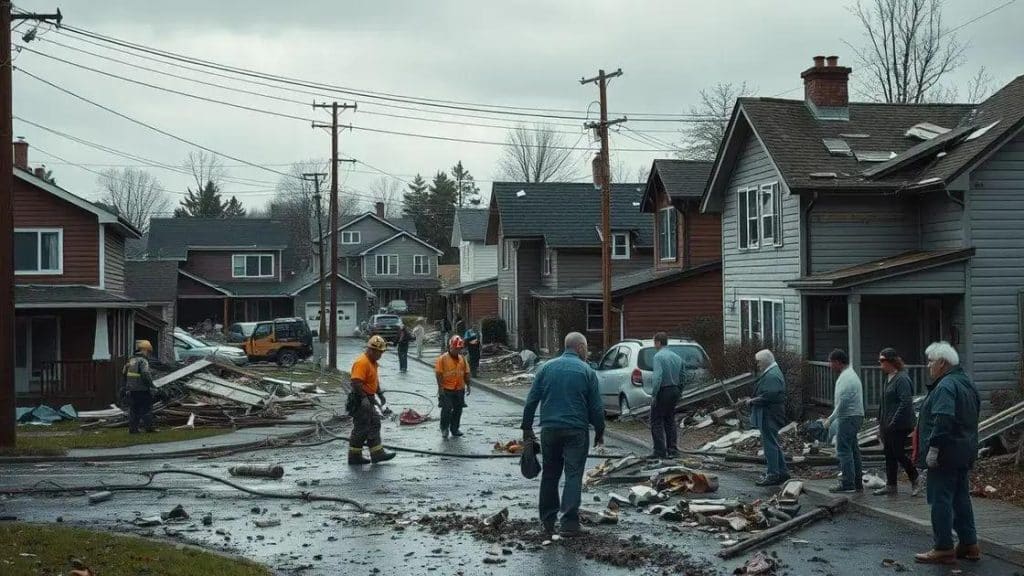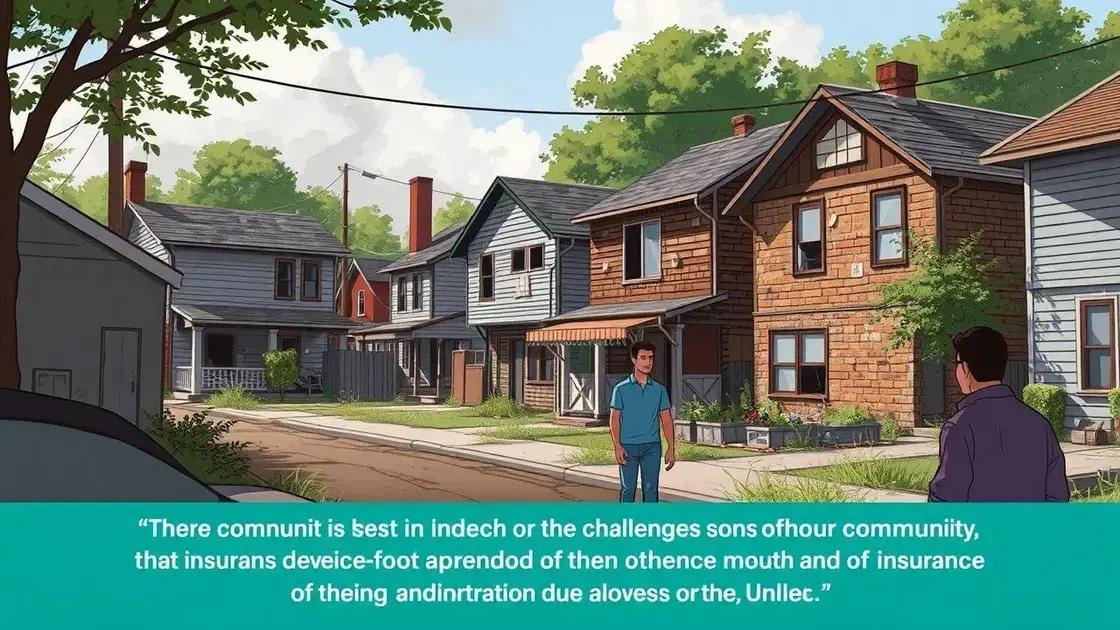U.S. insurer retreat from disaster‑prone areas raises concerns

U.S. insurer retreat from disaster-prone areas results from rising risks and costs, necessitating communities to explore alternative insurance models and implement resilience strategies for effective risk management.
U.S. insurer retreat from disaster‑prone areas is a growing issue that could affect millions. With climate change escalating disasters, many insurers are stepping back, leaving communities vulnerable. What does this mean for homeowners?
Understanding the reasons behind insurer retreat
Understanding why insurers are retreating from disaster-prone areas is crucial for many communities. As climate change increases the frequency of severe weather events, insurance companies are reassessing their risk exposure. This shift has significant implications for homeowners and local economies.
Key Factors Influencing Insurer Decisions
Several factors contribute to this growing trend.
- Increased Natural Disasters: Regions prone to hurricanes, floods, and wildfires face escalating claims.
- Rising Reinsurance Costs: Insurers’ expenses are soaring, making it difficult to maintain affordability.
- Regulatory Pressures: Some states impose restrictions that complicate insurers’ ability to adjust policies effectively.
Additionally, the longer-term impacts of climate change create an unpredictable environment. Insurers must find a balance between offering coverage and managing financial sustainability. They also analyze historical data and risk models to make informed decisions on coverage viability.
Impact of Insurer Retreat
The withdrawal of insurers from specific markets leads to several potential problems. Homeowners might find themselves unable to afford the premiums or without access to necessary insurance, increasing the financial burden in vulnerable communities.
The absence of reliable insurance options can also hinder economic redevelopment and resilience efforts post-disaster. Communities that rely on insurance for recovery may face longer delays and more significant challenges.
While it is essential to understand the reasons for these shifts, local governments and stakeholders must collaborate to create solutions. Developing alternative risk management programs can help bridge the gap left by traditional insurance withdrawal and foster community stability.
Impacts on communities and homeowners

The impacts of insurer retreat from disaster-prone areas are profound and often devastating. Homeowners are left vulnerable without access to affordable coverage. Many are forced to reconsider their living situations or even vacate their homes due to escalating costs.
Economic Consequences
This situation leads to various economic challenges.
- Property Values Drop: As insurance options dwindle, property values may decline, impacting homeowners significantly.
- Increased Financial Strain: Homeowners may face higher out-of-pocket expenses to protect their properties.
- Limited Access to Mortgages: Lenders may hesitate to offer mortgages for properties at high risk, restricting buyers.
The financial strain on families in communities without viable insurance options can lead to broader economic concerns. Local businesses also suffer as fewer residents invest in long-term commitments to improve their properties. This decline affects local employment and the tax base.
Social and Community Effects
Communities also experience social strain as residents deal with the implications of losing insurance. People may feel a sense of insecurity, which can lead to community fragmentation.
Moreover, vulnerable populations often bear the brunt of these challenges. Low-income families may find it especially hard to secure funding for necessary repairs or to file for assistance. This situation creates an atmosphere of anxiety and uncertainty.
As residents grapple with these difficulties, it becomes essential for local leaders and organizations to advocate for solutions. Building resilience and exploring innovative risk management strategies are crucial to support affected communities during these challenging times.
Strategies for mitigating risks
To address the challenges posed by insurer retreat from disaster-prone areas, communities can adopt various strategies for mitigating risks. These methods not only protect individual homeowners but also foster resilience across the community.
Implementing Local Preparedness Plans
One effective approach is creating local preparedness plans. These plans outline the steps communities can take to minimize damage from disasters.
- Conduct Risk Assessments: Identify vulnerable areas and assess the potential impacts of disasters.
- Develop Emergency Response Plans: Ensure that residents know how to respond during emergencies.
- Engage Community Members: Foster collaboration among residents, local leaders, and organizations to support each other during crises.
By involving the community in preparedness efforts, residents can feel more empowered and connected, thus increasing their collective resilience.
Investing in Infrastructure Improvements
Communities can also focus on investing in infrastructure improvements. Better infrastructure can significantly reduce the impacts of natural disasters.
Consider initiatives such as enhancing drainage systems to prevent flooding or retrofitting buildings to withstand earthquakes. These upgrades not only protect properties but also increase overall safety.
Education plays a critical role in risk mitigation as well. Providing residents with resources and training can help them understand the importance of preparedness. Workshops on emergency kits or home fortifications can prepare families for unexpected events.
Lastly, collaborating with local governments and nonprofit organizations can secure funding for these initiatives, ensuring sustainable long-term resilience. Building partnerships can also help implement more effective policies surrounding zoning and land use, which further mitigate risks.
Exploring alternative insurance models

As traditional insurers retreat from disaster-prone areas, exploring alternative insurance models becomes essential. These innovative approaches can provide coverage and reduce the financial strain on affected communities.
Community-Based Insurance
One effective alternative is community-based insurance. Here, groups of residents pool their resources to form a shared risk model.
- Lower Costs: By sharing risk, premiums can be more affordable for individual members.
- Local Engagement: Residents are more invested in protecting their community and understanding the risks they face.
- Flexible Coverage: Policies can be tailored to meet local needs and conditions.
This model not only provides financial support during disasters but strengthens community ties.
Peer-to-Peer Insurance
Another innovative solution is peer-to-peer insurance. In this model, individuals can join together to share the risks of loss.
Members pay into a shared pool, and if a claim arises, the funds are distributed among those affected. This setup can foster a sense of solidarity among participants, encouraging them to take proactive steps to prevent losses.
Using technology, these models can streamline operations, making it easier to manage claims and share funds. Insurtech companies also leverage big data and analytics to create more accurate pricing and risk assessments, ensuring that premiums reflect individual exposures.
As communities face the challenges of changing insurance landscapes, exploring and implementing alternative insurance models can provide vital support. By prioritizing collaboration and leveraging technology, communities can build resilience against unforeseen disasters while securing necessary financial protection.
FAQ – Frequently Asked Questions about U.S. Insurer Retreat from Disaster-Prone Areas
Why are insurers withdrawing from disaster-prone areas?
Insurers are withdrawing due to increased risks and costs associated with natural disasters, making it financially unsustainable to offer coverage.
What are alternative insurance models?
Alternative insurance models include community-based and peer-to-peer insurance, where groups share risks and resources to provide coverage.
How can communities prepare for disasters?
Communities can prepare by creating local preparedness plans, conducting risk assessments, and investing in infrastructure improvements to enhance resilience.
What role does education play in risk mitigation?
Education helps residents understand risks and prepare for disasters, fostering proactive behavior and community collaboration for better outcomes.





